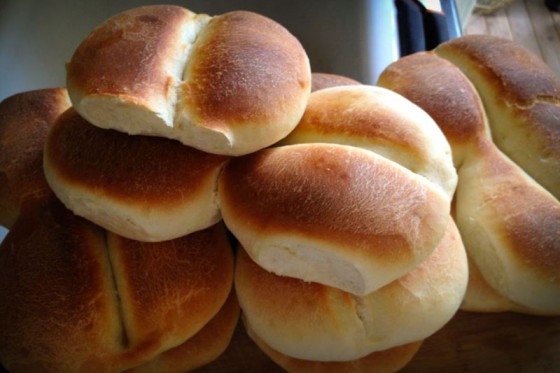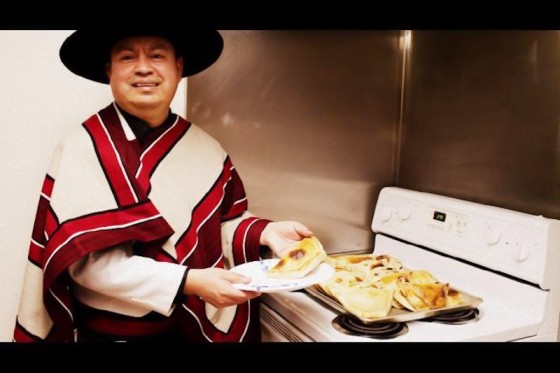Selling food out of your home is a common way to supplement income and sustain community in Latin America. Chilean chef Aurelio Pino is carrying on the tradition from a “secret” location in South Seattle.
The evening sky is an inky blue headed for black. It takes me a couple of passes to recognize the unlit white house as the correct address. The text-message instructions say “around back” so I park and set off down a long driveway — boots crunching gravel — toward a little yellow sign painted “Aurelio’s Kitchen.”
Inside the basement apartment, pools of candlelight glow on checkered tablecloths, and the air is thick with the smell of onions and olive oil. Aurelio Pino, Spanish language translator by day, stands at the stove next to a pot of simmering “Chilean-style rice” — drinking in a moment of calm before the first guests of the evening arrive.
“It started with small groups, 10 or 12 people,” says Pino, wooden spoon in hand, describing how he began an informal restaurant out of his home. “And then we started growing because those friends started inviting other people.”
Those original “customers” were drawn from the nearly 2,000 Chilean immigrants Pino says live in the Seattle area and are starved for the traditional dishes of their home country. Before Pino began his monthly dinners, he says, the nearest place to buy a proper Chilean meal was in Vancouver, B.C.
“We have special foods that sometimes you can’t find here,” says Marion Londres, who has been in Seattle since the 1980s and says she was among the people encouraging Pino to start “Aurelio’s Kitchen” about two years ago.
“Pop-up” restaurant is slang for a temporary restaurant. It’s a trendy term that has been used to describe anything from a new chef borrowing an existing restaurant for a night to underground restaurants operating out of private homes.
It’s a phenomenon often associated with ambitious foodies looking for low-cost and low-risk opportunities to test the waters of a tough industry in a shaky economy.
It’s also, in the case of selling food out of private homes, not exactly “allowed” as Pino puts it.
 Pan batido (aka marraqueta) is the quintessential Chilean staple. (Photo courtesy Aurelio Pino)
Pan batido (aka marraqueta) is the quintessential Chilean staple. (Photo courtesy Aurelio Pino)
Pino has a food-handler’s permit connected to his business catering Chilean pastries and says he tries to keep the dinners (which happen roughly once a month and typically serve 30 people) to “friends, or friends of friends.” He also emphasizes the community aspect of the gatherings instead of the price (about $15 per person to help cover supplies).
But for Pino, and many other Chileans at this night’s gathering, it’s also a familiar tradition of informal and rustic eateries sometimes referred to as picadas back in Chile.
Pino says the house next door to where he grew up in Santiago sold sopaipillas (a thick tortilla popular in cold rainy weather) and another down the street served up hot dogs the Chilean way (with avocado, tomato and mayonnaise) out of an open window.
Tonight’s menu is a little more sophisticated. Appetizers are empanadas — tender pastry dough stuffed with smoky ground beef and paired with a chopped tomato and onion salsa called pebre.
For a main course I try the curanto en olla, a dish featuring fish, clams, mussels, sausage and chicken simmered together in a white-wine sauce so potent Pino jokes “It could get you drunk.”
Throughout the meal little pyramids of pan amasado — salty, golden biscuits heavy with olive oil and perfect for sopping up the curanto’s rich broth — are passed around the communal tables.
As “Aurelio’s Kitchen” fills up with eager diners, some seated in recliners and couches in his living room, shouts of recognition often rise above the din. But there are also newcomers like me — a testament to Pino’s growing reputation.
“Every time, he has more people,” says Londres shaking her head above a steaming bowl of curanto.
Because of the underground nature of Pino’s operation (Londres describes his dinners as “not secretive but kind of exclusive”), I can’t tell you exactly how to get invited to a dinner. Pino’s joking piece of advice is to “make friends with a Chilean.” He says most everyone in the community knows him through a few degrees of separation.
However you do it, I’d hurry — he’s already planning next month’s menu.



I’m going to seattle in may and I would love to go and try his Chilean food I’m from chile and I miss all the traditions is a phone number or a web site thank u
You can find Aurelio’s catering business here:
http://www.aurelioskitchen.com/
Enjoy!